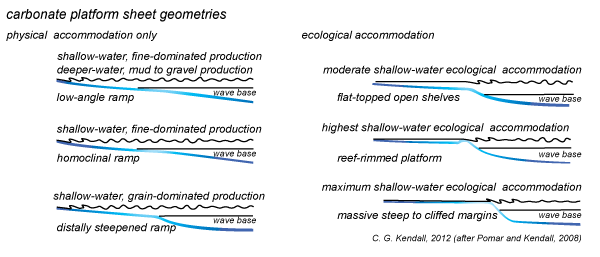|
accommodation
distally steepened ramp
ecological accommodation
eustasy
low angle ramp
massive steep margin
physical accommodation
reef-rimmed margin
|

Read (1982, 1985) divided ramps into homoclinal ramps and distally steepened ramps. In the figure above homoclinal ramp geometries are portrayed as the product of finer shallow-water carbonate. These ramps have uniform, gentle slopes (<1°) that extend out into the adjacent basin. They capture depositional settings that extend from 1) peritidal and lagoonal settings; 2) shallow-water bank complexes; 3) open marine, deeper ramp, muddy sediments; and 4) slope and basin lime muds and interbedded shales (Read, 1985; DeKeyser et al 2010). Modern homoclinal carbonate ramps include the Arabian or Persian Gulf and Shark Bay, Australia. In these examples of physical accommodation the carbonate accumulation rates do vary slightly down depositional dip. They illustrate that despite their similar depositional profiles, the facies differences reflect down dip differences in the production/accumulation processes (Pomar and Kendall, 2008).
Carbonate systems, and in particular platform exhibit a diversity that is a result of a wide variety of carbonate production processes and mechanisms that cause their redistribution within the basin. Each different biotic system has a unique competence (ecological accommodation) for building above and below the hydrodynamic shelf equilibrium profile of Swift and Thorne (1991). Thus production depends on biological evolution including ecological requirements (substrate, competitive displacement, etc); the type, size and efficiency of the carbonate factory, which in turn, depends on the area available to thriving carbonate producing biota (basin floor physiography), on intrabasinal conditions (nutrients, temperature, water energy, water transparency, salinity, oxygen, Ca2+ and CO2 concentrations, Mg/Ca ratio, alkalinity, etc). Furthermore, sediment dispersal depends on the interaction between the physical characteristics of the different types of sediment being produced (grain size, bulk density as determined by porosity within the grain e.g. intraskeletal porosity, etc) and the hydraulic energy ambient to the production loci, and its modification by binding, trapping, baffling and framework building (Ginsburg and Lowenstam, 1958) as well as by early cementation processes.
So, ecological accommodation matches the accommodation of Jervey (1998) as the "the space available for potential sediment accumulation" but with some less than subtle considerations. This ecological accommodation represents the "potential" space available for carbonate sediment to fill and is the combined product of rates of carbonate sediment accumulation as modulated by the ecological requirements of the carbonate producing organisms, movement of the sea surface (eustasy: global sea level measured from a datum such as the center of earth) and movement of the sea floor (tectonics).
References
Ginsburg, RN, and Lowenstam, HA, 1958, The influence of marine bottom communities on the depositional environments of sediments: Journal of Geology, v. 66, p. 310-318.
Jervey, M.T., 1988, Quantitative geological modeling of siliciclastic rock Sequences and their seismic expression, in Wilgus, C.K., Hasting, B.S., Kendall, C.G.St.C, Posamentier, HW, Ross, CA, and Van Wagoner, JC, eds., Sea-level changes: an integrated approach: Tulsa, OK, Society of Economic
Paleontologists and Mineralogists, Special Publication No. 42, p. 47-69.
Posamentier, Henry W., and George P. Allen, 1999, "Siliciclastic Sequence Stratigraphy - Concepts and Applications", published by the Society of Economic Petrologists and Paleontologists, 216 pages.
Pomar, L., 2001 (a), Ecological control of sedimentary Accommodation: evolution from a Carbonate ramp to rimmed shelf, Upper Miocene, Balearic Islands: Palaeogeography, Palaeoclimatology, Palaeoecology, v. 175, p. 249-272.
Pomar, L., 2001 (b), Types of Carbonate platforms, a genetic approach: Basin Research, v. 13, p. 313-334.
Pomar, L. and Kendall, C. G. St. C., 2008, ,Architecture of carbonate platforms: A response to hydrodynamics and evolving ecology. In: Controls on carbonate Platform and Reef Development – J. Lukasik & A. Simo (Eds.). ISBN 978-1-56576-130-8, SEPM Special Publication No. 89, p. 187-216
Swift, D.J.P., and Thorne, J.A., 1991, Sedimentation on continental margins, I: a general model for shelf sedimentation, in Swift, D.J.P., Oertel, G..F, Tillman, R.W., and Thorne, J.A., eds., Shelf sand and sandstone bodies, International Association of Sedimentologists Special Publication, No. 14, p. 3-31.
|